Stock buying during the January selloff is working again - but when should you sell the rally?
The market rally in 2023 so far has seen the S&P 500 up over +25%, the ASX 200 up +14%, and the Small Ords up +19% in the last five months. Find out why in the following wire and whether I believe it can continue in this excerpt of the full report. This follows on from one I published in January - which you can read here.
In summary, the following are considered:
- On “average” the Jan low to the end of April has made up 90% of the year’s total gain.
- Why selling (or going underweight) in late April is a good strategy most years.
- Sell in May – you can see ASX 200 does poorly from May to September.
- Substantials
- Dividends paid this week and next (see table below):
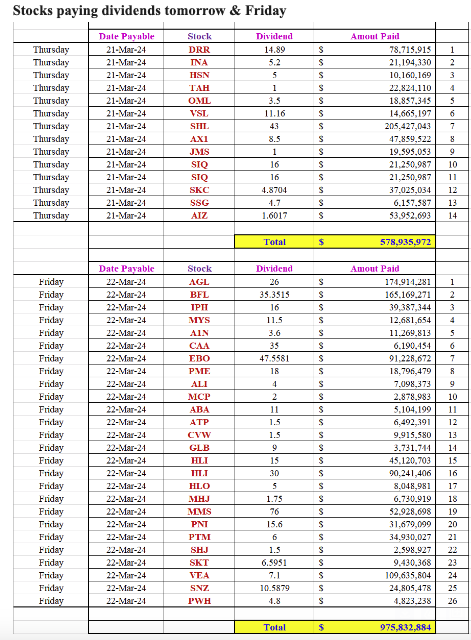
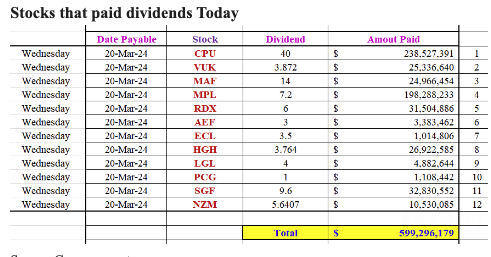
Market Thoughts
There is no doubt that this extraordinary rally has caught many fund managers across the world with their pants down. They, along with a number of very high-profile brokers, have held firm the whole way that the rally was overdone at +10%, at +15%, at +18%, at +22%. Here we now are at +25% and still they hold firm.
When you are in a new bull market it always – yes, always, 100% of the time – is seen at the time – as a “Bear Market Rally”.
It looks like the (so-called by you-can-guess-who uses this term!) “dumb money” – or the ”retail investors” have been at the forefront of this rally and buying. While the “smart money” has not been sucked in by this “false rally” and has stayed out – as they know better than all these idiots who have been buying.
These institutional investors (and others) are underweight equities, overweight cash and they want to buy equities. But they want them a lot lower than where they are now (hence they will buy the dips – when they come).
So, those who have been buying (and those who have just held their long positions) have been on the right side of this rally, that has seen the S&P 500 up over +25%, the ASX 200 +14% & the Small Ords up +19% in the last five months.
- There will be a pullback, this is a fact, not a prediction - now when and how much are the only unknown variables at the moment that are “unknown”.
- There will be a selloff – I think it will be in the range of -5% to -7.5% (there is a very good reason why I always use this range) & IF it is in this range – it’s super bullish that the market will rally back and make new highs.
The timing is always the hardest thing to predict (as so many US brokers and high-profile fund managers have found out in the last three months).
It is near impossible to pick the market high – or the exact level where a correction or selloff starts from – as I have noticed over the years. Once a market has “momentum” then no matter how many times you say the P/E is possibly trading at “x above” its long-term average – it means nothing when the market has a different focus.
So, when will this selloff occur? As I said, they are almost impossible to predict, but I’ll have a go. I see two possible windows:
- The first is right now – If the Federal Reserve said something about lingering inflation or something else that shocks the market – then that could be the “spark” that lights the selloff bomb.
- If not now - then 5 to 6 weeks from now – I use another historical tool - one that has been pretty good over the last 30 to 50 years.
Sell in May and go away
Okay, I know it may sound like a cliché but it’s the old “Sell in May and go away.”
I pushed the market as a strong buy back in October and have stayed long and kept on the buy side all the way now for the last five months. But I think we are now stretching that rubber band a little bit too hard & there is not a lot of “slack” left in it.
I also pushed the market as a buy (for those who did not buy in October or in December) during the Jan lows (in mid-Jan this year). Below, I show why doing that and holding until the end of April is a good idea.
In the last 31 years, this 3.5-month stretch has been up 84% of the time. During the period, the returns have been 5.9% (or 6.6% if we were to exclude March 2020’s -17.2% collapse).
While more specifically, the 26 times (out of 31 years) that the ASX 200 was up in this period, the gains were huge at +8%.
Right now in (late March) 2024 – the returns on the ASX 200 on this strategy are running - so far - at +5.3%, so if we just do the “average” then it implies another +2.7% rise over the next five weeks.
So, we know that the ASX 200 is up +5.9% (or +8% in the up years), so selling or taking profits or increasing your cash levels near the end of April is usually a very good strategy.
The reason why “Sell in May and go away” works is shown in the numbers – the ASX 200 from May until September (the next five months) has been down 51% of the time (versus Jan low to April, which is up 84% of the time).
But also, the average return has been just +0.14% for these five months (since 1993).
I provide more on this in deep detail below.
BUYING the market in the January selloff - sees big returns
How the ASX 200 - or big caps perform, WHEN BUYING DURING THE JAN SELLOFF. Also, LOOKING AT THE "PERIOD AFTER" (the bad period)- does "Sell in May" really work ?) In addition, we look at how the Small Caps performed in this period.
- This year (2024) the ASX 200 at its low in Jan was down -3.3%
- And from that low it is now up +5.3%
I push the market as a strong BUY most years - from mid-December for a run into early January (but last year I pushed it hard as a BUY in October & then again in Mid Dec)
- Look at the numbers below - they are hard quant numbers that have "no emotion" - because I've seen this so many times over the last 30 years. I did a deep dive into this period and the numbers came out exactly as I thought. As I've seen markets play out so many times over such a long period.
- Of course, it doesn't happen every year - but it happens far too many times to be just a "coincidence".
- So being net long the market for the 3.5 months to the end of April - has been a winning strategy so many times.
What are the returns over this period?
Over the last 31 years, one of the best buying opportunities has been to buy during the selloff that the market has most January’s and holding for three and a half months until the end of April.
This strategy has had a phenomenal winning success rate of 84%. That is, in the last 31 years, it’s been up 26 times.
The average rise over those 3.5 months has been a massive +5.89% (before the shocking -17.2% drop in 2020 – thanks to COVID – it had been running at an average rise of +6.57%).
And considering the average gain in "the ASX 200 each year (over 12 months)" since 1993 has been +6.35% - this is very significant.
While the 26 times it was up, the return was a massive +8%.
Selling at April high - even better...
- The moves from Jan low to the high in APRIL are even better – sometimes selling out before the end of April has seen returns of +12.5%
- This looks at buying in Jan low & selling in April at the high (in reality no one gets low & high correct - but what it shows is the magnitude of the moves)

This shows the difference between selling at the end of April vs selling at the high in April.
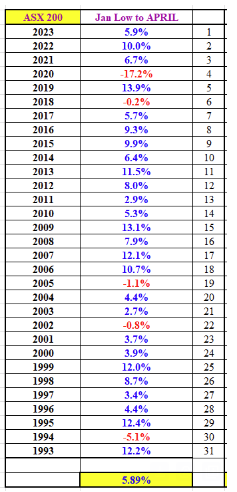
Looking at the small caps, the difference between selling at the end of April (4.64%) versus earlier (at the high) is massive - at 13.62%.
So, selling small caps in mid-April rather than waiting for the end of the month gives huge returns.
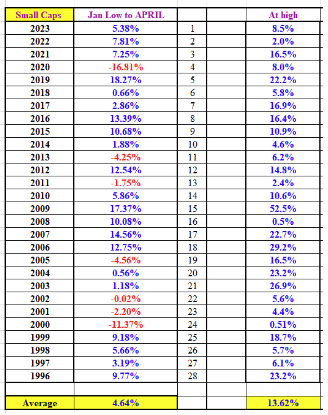
The years when the ASX 200 was down for the year
Even the nine down years in the last 31 since 1993, this period did better than the yearly more.
Every year (bar COVID in early 2020), they OUTPERFORMED significantly - and also by a massive margin versus where the market closed for that year.
So again, it’s just a reminder that the first four months of the year are safer times to be long. If you are worried about the year, then reducing net long positions by the end of April can be a very good strategy.
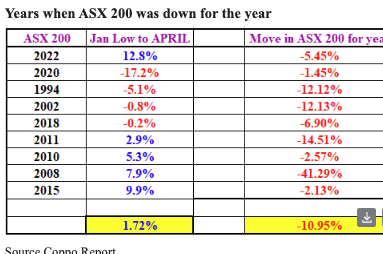
This chart shows how this period was a winner in every bad year that the ASX 200 has had since 1993 (bar 2020, when COVID hit hard)!
Now this is amazing and you really need to see this:
We saw above how big this period was in the down calendar years.
- But now look at the 22 years in the last 31 since 1993, when the ASX 200 closed higher.
- How important has it been to be long for these 3.5 months?
VERY….
Look at the table first:
On “average” the Jan low to the end of April has "on average" made up 90% of the year’s total gain (but that is distorted by 1998, 2000, 2014 and 2016 being exceptionally strong - that drags up the average to that number).
The yellow highlighting shows when these three-and-a-half months made up over 50% of that total year’s gains!
On average, Jan's low to the end of April has made up 90% of the year's total gains.
Only 4 times in the 22 years when the market was higher for that year was the return less than 40% for the year.
- So in the other 18 years or 81% of the time this period made up for over 40% of the whole year's gains
- And even more extraordinary...
- So 18 times in those 22 up years – or 81% of the time we saw this period make up 40% - or more - of the total gains for the year
Looking at the 22 years the market was up
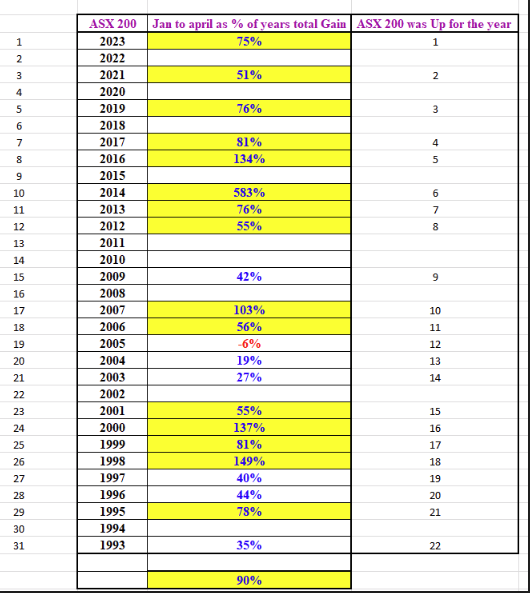
Looking at the ASX 200
- It has closed down 16 years out of the last 31 years or 51% of the time (versus January to April down just 16% of the time)
- Thus it has only closed up just 49% of the time (May to Sept) vs 84% for Jan to April
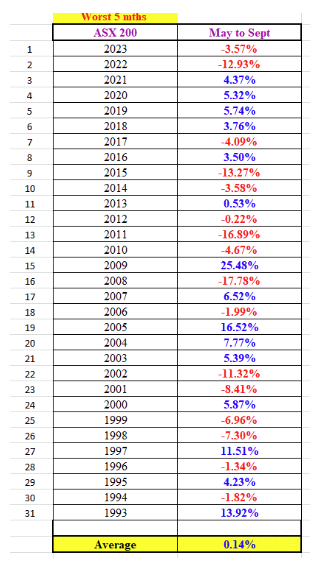
Get more insights from the insto desk in the Coppo report
This article is an excerpt from The Coppo Report contributed to Livewire by Richard Coppleson, Director - institutional sales and trading, Bell Potter. You can find out more here.
You can also stay up to date with the latest news by hitting the ‘follow’ button and you’ll be notified every time I post a wire.
1 topic

